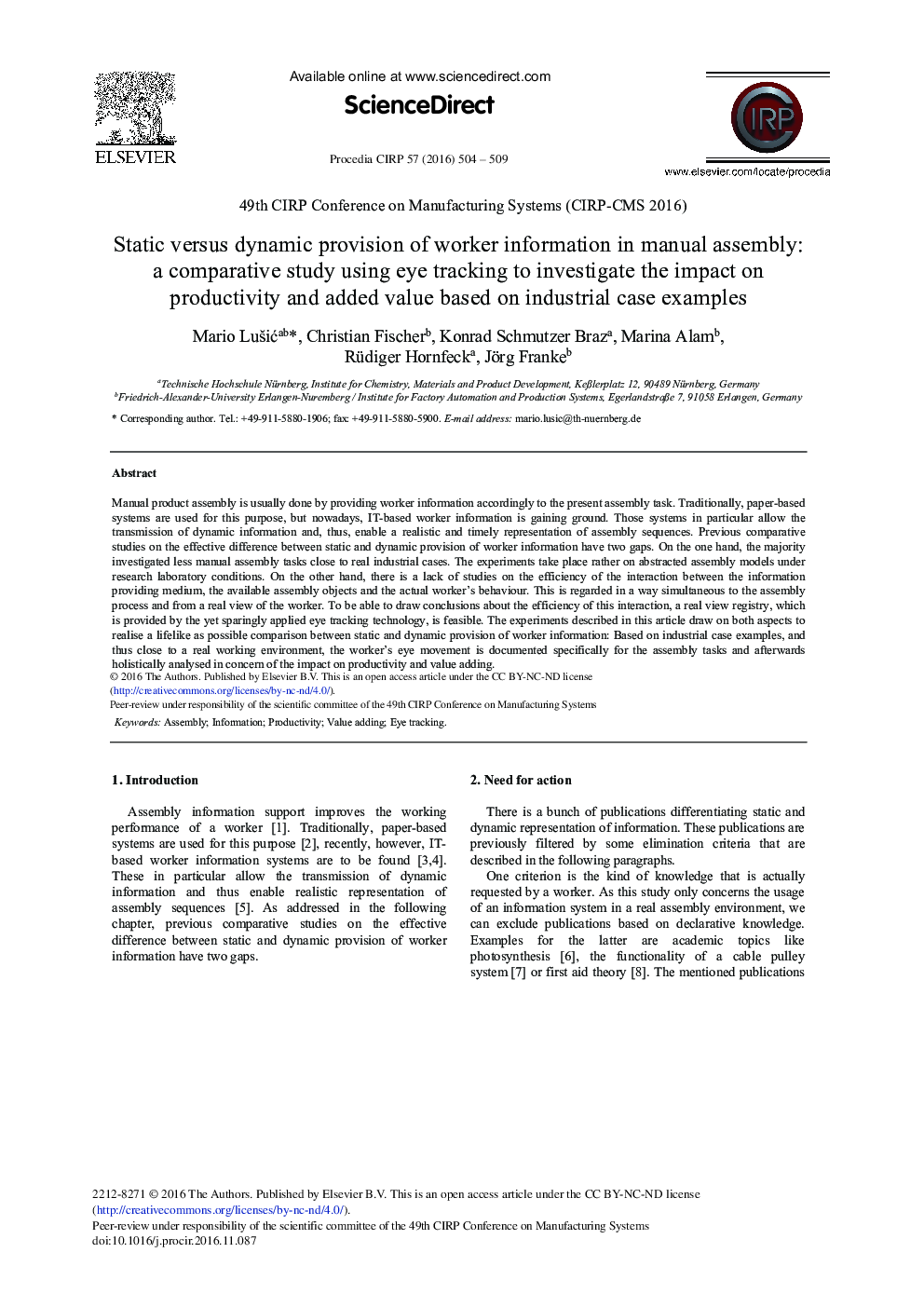| کد مقاله | کد نشریه | سال انتشار | مقاله انگلیسی | نسخه تمام متن |
|---|---|---|---|---|
| 5469870 | 1519295 | 2016 | 6 صفحه PDF | دانلود رایگان |
عنوان انگلیسی مقاله ISI
Static Versus Dynamic Provision of Worker Information in Manual Assembly: A Comparative Study Using Eye Tracking to Investigate the Impact on Productivity and Added Value Based on Industrial Case Examples
ترجمه فارسی عنوان
استاتیک در مقابل ارائه پویا اطلاعات کارگر در مجمع دستی: مطالعه مقایسه ای با استفاده از پیگیری چشم برای بررسی تاثیر بر بهره وری و ارزش افزوده بر اساس نمونه های صنعتی
دانلود مقاله + سفارش ترجمه
دانلود مقاله ISI انگلیسی
رایگان برای ایرانیان
کلمات کلیدی
مونتاژ، اطلاعات بهره وری، ارزش افزوده، ردیابی چشم،
ترجمه چکیده
مونتاژ محصول دستی معمولا با ارائه اطالعات کارگر براساس مأموریت فعلی مونتاژ انجام می شود. به طور سنتی، سیستم های مبتنی بر کاغذ برای این منظور استفاده می شود، اما امروزه اطلاعات کارگر مبتنی بر فناوری اطلاعات بر روی زمین افزوده می شود. این سیستم ها به طور خاص اجازه انتقال اطلاعات پویا را می دهد و بنابراین، نمایش واقعی و به موقع توالی های مونتاژ را فعال می کند. مطالعات مقدماتی قبلی در مورد تفاوت مؤثر بین اطلاعات استاتیک و پویا ارائه اطلاعات کارگری دارای دو شکاف است. از یک طرف، اکثریت کمتر از وظایف دستیار دستی نزدیک به موارد صنعتی واقع شده اند. آزمایش ها بر اساس مدل های مونتاژ انتزاعی تحت شرایط آزمایشگاهی انجام می گیرد. از سوی دیگر، مطالعاتی در مورد کارایی تعامل میان رسانه ارائه دهنده اطلاعات، اشیاء مونتاژ موجود و رفتار واقعی کارگر وجود دارد. این به طور همزمان به روند مونتاژ و از دیدگاه واقعی کارگر در نظر گرفته می شود. برای توانایی کشف نتیجه در مورد کارایی این تعامل، یک رجیستری دیدگاه واقعی، که توسط فن آوری ردیابی چهره هنوز به کار رفته است، امکان پذیر است. آزمایشات توصیف شده در این مقاله بر روی هر دو جنبه برای به رسمیت شناختن یک مقایسه واقعی بین مقیاس های استاتیک و پویا از اطلاعات کارگر می پردازند: بر اساس نمونه های صنعتی و به همین ترتیب نزدیک به یک محیط کاری واقعی، حرکت جنبش کارگری به طور خاص برای وظایف مونتاژ و پس از آن به طور کلی در مورد تاثیر بر بهره وری و ارزش افزوده مورد تجزیه و تحلیل قرار گرفته است.
موضوعات مرتبط
مهندسی و علوم پایه
سایر رشته های مهندسی
مهندسی صنعتی و تولید
چکیده انگلیسی
Manual product assembly is usually done by providing worker information accordingly to the present assembly task. Traditionally, paper-based systems are used for this purpose, but nowadays, IT-based worker information is gaining ground. Those systems in particular allow the transmission of dynamic information and, thus, enable a realistic and timely representation of assembly sequences. Previous comparative studies on the effective difference between static and dynamic provision of worker information have two gaps. On the one hand, the majority investigated less manual assembly tasks close to real industrial cases. The experiments take place rather on abstracted assembly models under research laboratory conditions. On the other hand, there is a lack of studies on the efficiency of the interaction between the information providing medium, the available assembly objects and the actual worker's behaviour. This is regarded in a way simultaneous to the assembly process and from a real view of the worker. To be able to draw conclusions about the efficiency of this interaction, a real view registry, which is provided by the yet sparingly applied eye tracking technology, is feasible. The experiments described in this article draw on both aspects to realise a lifelike as possible comparison between static and dynamic provision of worker information: Based on industrial case examples, and thus close to a real working environment, the worker's eye movement is documented specifically for the assembly tasks and afterwards holistically analysed in concern of the impact on productivity and value adding.
ناشر
Database: Elsevier - ScienceDirect (ساینس دایرکت)
Journal: Procedia CIRP - Volume 57, 2016, Pages 504-509
Journal: Procedia CIRP - Volume 57, 2016, Pages 504-509
نویسندگان
Mario LuÅ¡iÄ, Christian Fischer, Konrad Schmutzer Braz, Marina Alam, Rüdiger Hornfeck, Jörg Franke,
